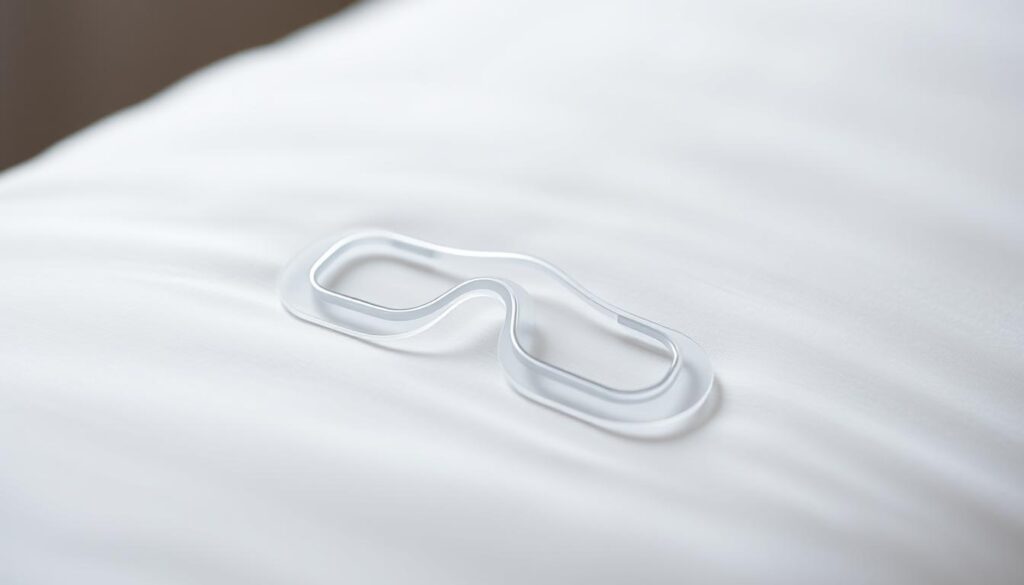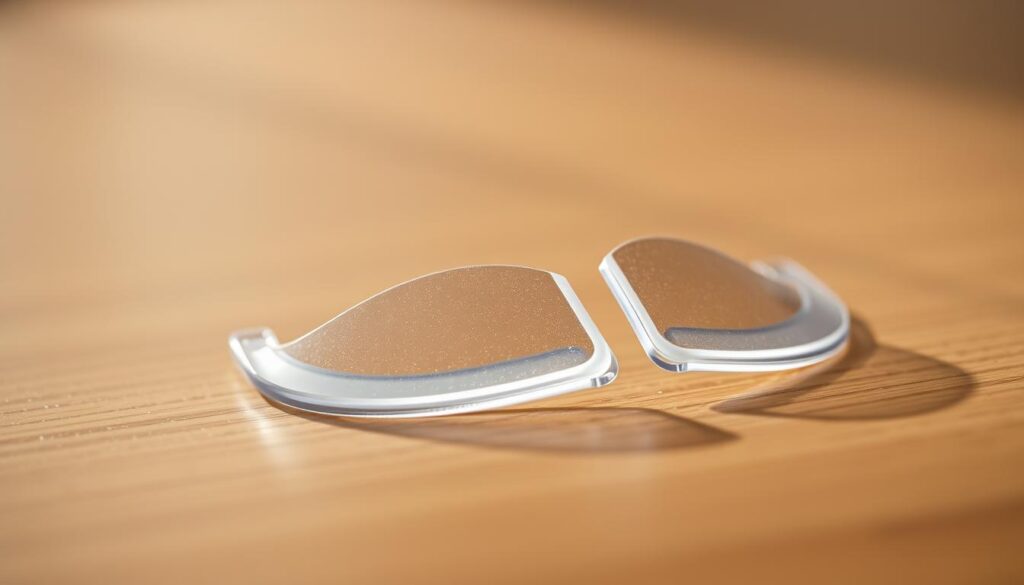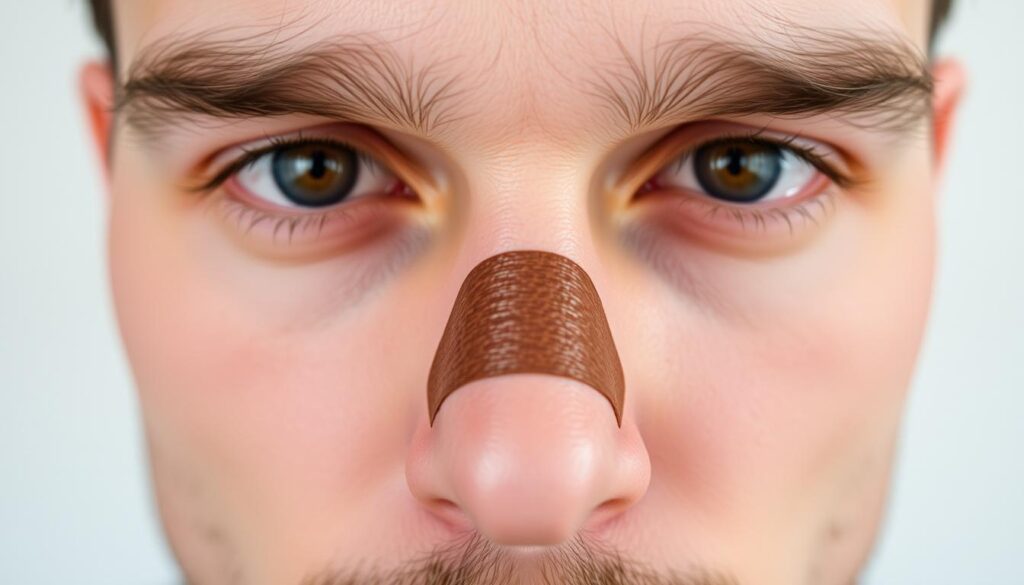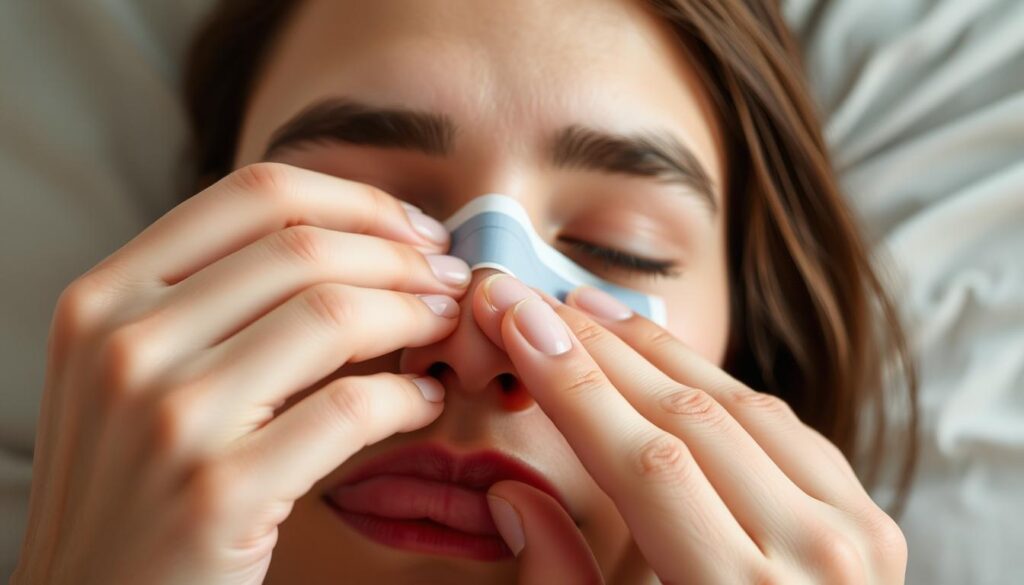
Imagine a tiny adhesive strip that could cut your snoring in half. Over 90 million Americans snore regularly. Nasal strips, small, spring-like bands for the nose, are a popular choice for relief. They lift nasal passages to improve airflow, making nights quieter for you and your partner.
Using nasal strips is simple: just apply one before bed. They open nasal pathways, reducing the vibrations that cause snoring. While some studies show they help, others have mixed results. Still, many users find them helpful for easier breathing and less snoring.
Key Takeaways
- Nasal strips widen nostrils to improve airflow and reduce snoring sounds.
- Effectiveness varies—some research shows reduced snoring, while others find little difference.
- They’re not a cure for sleep apnea but can offer temporary relief for mild snoring.
- Possible side effects include skin irritation or a sneeze-like sensation.
- Alternatives like mouth exercises or medical procedures exist for persistent cases.
Understanding the Impact of Snoring on Your Health and Relationships
Snoring is more than just a noise at night. It’s a sign of a health issue. For over 40% of Americans, it messes up sleep and daily life. Let’s look into why it happens and its effects on health.
What Causes Snoring and Who Is Most Affected
Snoring happens when air has trouble getting through your airways. Narrowed nasal passages, a relaxed tongue, or extra tissue vibrate, making noise. Common causes include:
- Nasal congestion or a deviated septum
- Being overweight (extra tissue narrows airways)
- Alcohol or sedatives that relax throat muscles
- Sleeping on your back
Men are more likely to snore: 44% of males aged 30–60 snore compared to 28% of women. People with allergies or sinus problems are also at risk.
The Physical and Emotional Consequences of Chronic Snoringing
Snoring can make you tired, give you headaches, and make you irritable. It can make work and relationships harder. Partners often lose sleep too, which can strain relationships.
Research shows couples sharing a bed with a snorer lose 300+ hours of sleep yearly. Emotional stress and resentment can build up if it’s not treated.
“Chronic snoring disrupts sleep patterns, leading to impaired memory and focus.”
When Snoring Might Indicate a More Serious Condition
Watch out for gasping, choking sounds, or pauses in breathing. These could mean obstructive sleep apnea, a serious condition. Other warning signs include morning headaches, dry mouth, or falling asleep during the day. If you see these signs, see a sleep specialist.
While snoring treatment options like nasal strips help mild cases, severe cases need medical help.
Ignoring chronic snoring can harm your health long-term. Finding snoring remedies early can prevent heart problems or diabetes linked to poor sleep. Your health and your partner’s peace of mind are worth the effort to fix it.
How to Stop Snoring with Nasal Strips
Looking for how to stop snoring with nasal strips? The first step is to pick the right one. Choose nasal strips for snoring that match your nose size and needs. Brands like Breathe Right have different strengths, from regular to extra-strength, for a good fit.
- Clean your nose and the area around it to help the adhesive stick well.
- Peel off the backing and put the strip across your nose’s bridge. Make sure it’s in the middle of your nasal passages.
- Press it firmly to make the adhesive work. It should feel snug but not too tight.

Snoring strips target the nasal passages, reducing up to 60% of breathing resistance, per clinical studies.
Don’t make the common mistake of placing the strip too high or low. This can block airflow. If you get irritation, try hypoallergenic strips. Also, use tips to reduce snoring like sleeping on your side or avoiding alcohol before bed.
If your snoring is really bad, see a doctor. Snoring might mean you have sleep apnea, which affects many people. Remember, using these strips right and with other methods is the best way to get lasting relief.
The Science Behind Nasal Strips and Their Effectiveness
Nasal strips are part of anti-snoring products that help with breathing. They make the nasal passages wider. This reduces the noise caused by snoring. They won’t solve all snoring problems, but they help many people.
How Nasal Strips Work to Open Airways
Nasal strips have tiny springs that gently open the nostrils. This makes the airways wider. With wider airways, there’s less vibration in the soft tissues. This means less noise at night.

Clinical Evidence Supporting Nasal Strips for Snoring Reduction
“Breathe Right nasal strips reduced snoring intensity by 67% in a 14-day study, according to bed partner evaluations.”
A 2002 study followed 35 people who snored a lot. After two weeks, those using Breathe Right strips snored less and felt more awake in the morning. Even though some measures didn’t change, people felt better. This shows they can help with snoring caused by nasal congestion.
Comparing Brands and Types of Nasal Strips
- Breathe Right: A pioneer with flexible springs and hypoallergenic adhesives. Ideal for moderate congestion.
- Walgreens Smart-Flex: Budget-friendly option with adjustable adhesion strength for sensitive skin.
- ZzzQuil Sleep Nasal Strips: Clear design for discreet use, plus extra-strength options for wider nostrils expansion.
Choosing the best nasal strips for snoring depends on your needs. Those with nasal allergies or congestion may benefit most. Always test a small area first to avoid irritation.
Nasal strips aren’t a cure for sleep apnea, but they’re safe and easy to use. If snoring doesn’t go away, talk to a doctor.
Best Practices for Using Nasal Strips to Maximize Results
Getting the most from nasal strips for better sleep starts with proper application. Clean and dry your nose before use—moisture or oils can reduce adhesion. Place the strip gently over the bridge of your nose, pressing edges firmly for a secure fit. For best results, pair them with other snoring solutions like adjusting your sleep position.

- Side effects: Mild skin irritation? Rotate application areas or try hypoallergenic brands. Pause use if redness persists.
- Sleep adjustments: Sleep on your side. Elevate your head 4 inches with a pillow to reduce airway blockage.
- Hydration matters: Drink water during the day. Use saline sprays to keep nasal passages clear.
If snoring persists, address underlying causes like allergies or congestion. Weight loss and avoiding alcohol 2 hours before bed can boost effectiveness. Studies show nasal strips reduce snoring by up to 10% in non-OSA cases. Always consult a doctor if snoring is severe or paired with daytime fatigue.
Stick to consistent use—most users see results within a few nights. Combine these steps with lifestyle tweaks to enjoy quieter nights and better rest.
Conclusion: Taking Control of Your Sleep Quality with Nasal Strips
Nasal strips for snoring can be a useful tool. Studies show they help some people sleep better. But, results can vary.
For example, 92% of users of Breathe Right Nasal Strips reported better sleep in two weeks. Yet, a placebo group also showed similar improvements. This shows nasal strips can be a good option for those with nasal congestion or minor issues.
If you try nasal strips, remember they’re not a complete solution. If you have pauses in breathing or gasping, you might have sleep apnea. This needs a doctor’s check-up.
For sleep apnea, CPAP machines or oral appliances might be better. Avoiding alcohol and sleeping on your side can also help.
A 2016 JAMA review found nasal strips like Breathe Right can reduce snoring for some. But, it depends on your situation. Always talk to a doctor if snoring affects your sleep or your partner’s.
Nasal strips are a good start, but combining them with other strategies works best. Take control of your sleep. Try nasal strips, track their effect, and get expert advice if needed. Your restful nights are worth the effort.











